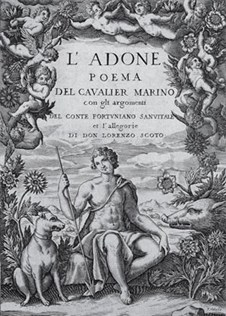Giambattista Marino
 Giambattista Marino (1569-1625) was the leading exponent of the literary Baroque in Italy. Born in Naples, he was sent to study law in order to follow the profession of his father. His passion for letters, however, soon got the upper hand. Initially he had the protection of powerful lords, like Duke Ascanio Pignatelli or the Prince of Capua. Forced to flee from Naples in 1600 for problems with the law, he moved to Rome in the service of Cardinal Pietro Aldobrandini, then to Ravenna, Venice and, from 1608 to 1611, in Turin, at the court of Charles Emmanuel of Savoy. The period of Piedmont, successfully started, but ended bitterly, with legal problems and, this time, even with prison. Released from jail, Marino began the happier and most glorious phase of his life: he was invited to the court of France by Marie de ‘Medici, the widow of Henry IV, and lived in Paris from 1615 to 1623, honoured and respected. The publication of his L’Adone, the poem of more than 40,000 verses, widely considered as his masterpiece and as the summit of the Italian Baroque poetry, dates from 1623 in Paris. In the same year he decided to return to Naples, where he was received with enthusiasm and praised by the Academies of the Infuriati (Enraged) and the Oziosi (Idle), despite the condemnation by ecclesiastical censorship that already affected L’Adone and the author’s works.
Giambattista Marino (1569-1625) was the leading exponent of the literary Baroque in Italy. Born in Naples, he was sent to study law in order to follow the profession of his father. His passion for letters, however, soon got the upper hand. Initially he had the protection of powerful lords, like Duke Ascanio Pignatelli or the Prince of Capua. Forced to flee from Naples in 1600 for problems with the law, he moved to Rome in the service of Cardinal Pietro Aldobrandini, then to Ravenna, Venice and, from 1608 to 1611, in Turin, at the court of Charles Emmanuel of Savoy. The period of Piedmont, successfully started, but ended bitterly, with legal problems and, this time, even with prison. Released from jail, Marino began the happier and most glorious phase of his life: he was invited to the court of France by Marie de ‘Medici, the widow of Henry IV, and lived in Paris from 1615 to 1623, honoured and respected. The publication of his L’Adone, the poem of more than 40,000 verses, widely considered as his masterpiece and as the summit of the Italian Baroque poetry, dates from 1623 in Paris. In the same year he decided to return to Naples, where he was received with enthusiasm and praised by the Academies of the Infuriati (Enraged) and the Oziosi (Idle), despite the condemnation by ecclesiastical censorship that already affected L’Adone and the author’s works.
